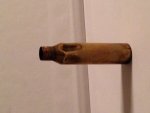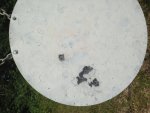PMR14,
Damoncali nailed it; too light a load, resulting in the brass failing to fully obturate and seal the chamber. Have to remember, the case serves to hold all the components together prior to firing, but once the trigger is pulled, it becomes little more than a gasket to seal the bore and combustion chamber off from the rest of the action, and prevent gasses from leaking where they're not supposed to go. In this case, your gasket failed. Too light a load, work-hardened brass in the neck area or a combination of both and this is what you see.
You also got good advice from both the Hornady and Hodgdon crews (no surprise there), and they are correct about the differential between data from different sources. Both are "right", and neither is "wrong." But you have to understand that both are "right" for those exact component combinations, and not necessarily for any other. This is why we always advise starting with the lower loads, and working up carefully as pressure signs allow. Your rifle, your components, etc., are all different from what they used to create that data, even if you're using the "same" types of components; different lot of primers, different lot of bullets, powders, cases, etc.. Switch to another brand than what the makers used in developing that data, and you see the problems that arise. The bump gage is a good investment, and using it faithfully will serve you well. You're on the right track here, no worries.



